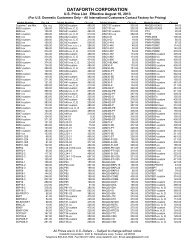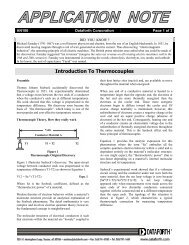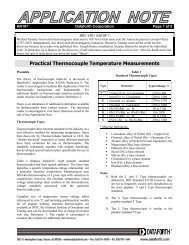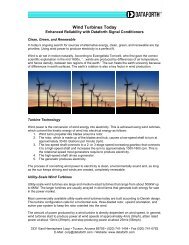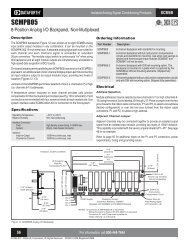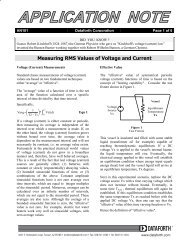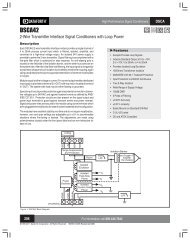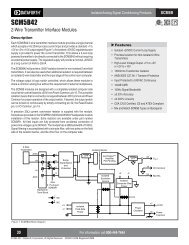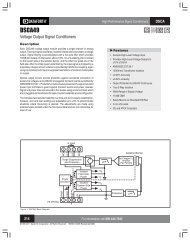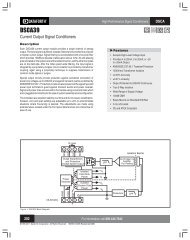rtd, resistance temperature detector - Scientific Devices Australia
rtd, resistance temperature detector - Scientific Devices Australia
rtd, resistance temperature detector - Scientific Devices Australia
You also want an ePaper? Increase the reach of your titles
YUMPU automatically turns print PDFs into web optimized ePapers that Google loves.
AN105 Dataforth Corporation Page 2 of 3<br />
Rearranging this expression gives;<br />
Resistance (V ÷ i) = [(ρ×L)÷A] , Ohms.<br />
applied<br />
Where ρ = 1/( e× n×µ<br />
) and is the familiar parameter<br />
“resistivity”, which characterizes <strong>resistance</strong> of any given<br />
material. Note that since the electron charge “e” is a<br />
constant, <strong>resistance</strong> is completely dominated and<br />
controlled by the product of (n) electron density and (µ)<br />
electron mobility. For most metals over a rather large<br />
range of <strong>temperature</strong>, the (n x µ) product decreases with<br />
increasing <strong>temperature</strong>; this increases <strong>resistance</strong> and<br />
establishes a positive <strong>temperature</strong> coefficient. The number<br />
of electrons and their complex interactive behavior<br />
controls the <strong>resistance</strong> of materials.<br />
The complex interactive behavior of billions of electrons<br />
scrambling down a wire under the influence of<br />
<strong>temperature</strong> and a forcing voltage creates a resistivity that<br />
is seldom linear over all <strong>temperature</strong>. However, Copper,<br />
Nickel, and Platinum do have near linear <strong>temperature</strong><br />
coefficients over certain ranges of <strong>temperature</strong> and,<br />
therefore, are used in the manufacture of RTDs. Platinum<br />
is the most linear.<br />
RTD Model<br />
RTD standards, define Platinum <strong>resistance</strong> vs <strong>temperature</strong><br />
behavior by the Callendar-Van Dusen equation, a nonlinear<br />
mathematical model. These standards include; the<br />
RTD value at 0 °C, R(0), equation coefficients, and a<br />
<strong>temperature</strong> coefficient, alpha (α) defined from 0 to 100<br />
°C. Alpha (α) can sometimes be used to establish a simple<br />
linear model for <strong>resistance</strong> vs <strong>temperature</strong>. In addition,<br />
different tolerance ranges identified as “classes” are<br />
included within the associated standard’s information.<br />
The Platinum RTD Callendar-Van Dusen non-linear<br />
model is a forth order polynomial for negative<br />
<strong>temperature</strong>s and a quadric for positive <strong>temperature</strong>s.<br />
Cases 1, 2, 3 below show models for the RTD in the<br />
general form of RTD = R(0) + ∆R, where ∆R is the<br />
<strong>temperature</strong> dependent part of the RTD.<br />
Measuring Temperature with RTDs<br />
Temperature measurements with RTDs first electronically<br />
measure the RTD <strong>resistance</strong> and then convert to<br />
<strong>temperature</strong> using the RTD’s <strong>resistance</strong> vs <strong>temperature</strong><br />
characteristics. There are numerous circuit topologies<br />
used to determine <strong>resistance</strong>. For example, Figure 1<br />
illustrates a classic bridge configuration used for 3-wire<br />
RTD measurements.<br />
RTD<br />
Rline3<br />
Rline2<br />
Rline1<br />
Field Side<br />
Rline1<br />
R3<br />
b<br />
a<br />
Module Side<br />
R2<br />
R1<br />
Figure 1<br />
The Classic 3-Wire RTD Bridge Topology<br />
Vref<br />
The voltage Vba in Figure 1 varies as RTD changes with<br />
<strong>temperature</strong>. For R1 = R2 = R3 = R(0), equal Rlines, and<br />
RTD defined as RTD = R(0) + ∆R then,<br />
Vref ⎡ ∆R ⎤<br />
Vba = ×<br />
2<br />
⎢<br />
2R(0)+∆R+2Rline<br />
⎥ .<br />
⎣<br />
⎦<br />
Typical bridge output voltages (as shown above) include<br />
line <strong>resistance</strong> and are non-linear.<br />
Modern semiconductor technology facilitates <strong>resistance</strong><br />
measurements with linear outputs and line <strong>resistance</strong>s<br />
eliminate. For example, Figure 2 illustrates a 4-wire RTD<br />
configuration with current excitation.<br />
Case (1) For T < 0; RTD = R(0) + ∆R<br />
2 3<br />
RTD = R (0) × [1 + A × T + B × T + C × ( T − 100) × T<br />
] .<br />
Case (2) For T > 0; RTD = R(0) + ∆R<br />
RTD = R (0) × [1 + A × T + B × T<br />
2<br />
] .<br />
RTD<br />
Rline4<br />
Rline3<br />
Rline2<br />
b<br />
a<br />
Iext<br />
Case (3) The linear model is; RTD = R(0) + ∆R<br />
RTD = R (0) × (1 + alpha × T<br />
) .<br />
Coefficients A, B, C, and alpha are defined by RTD<br />
standards and measured by RTD manufacturers as<br />
specified by these standards.<br />
Field Side<br />
Module Side<br />
Figure 2<br />
4-Wire RTD with Current Excitation




